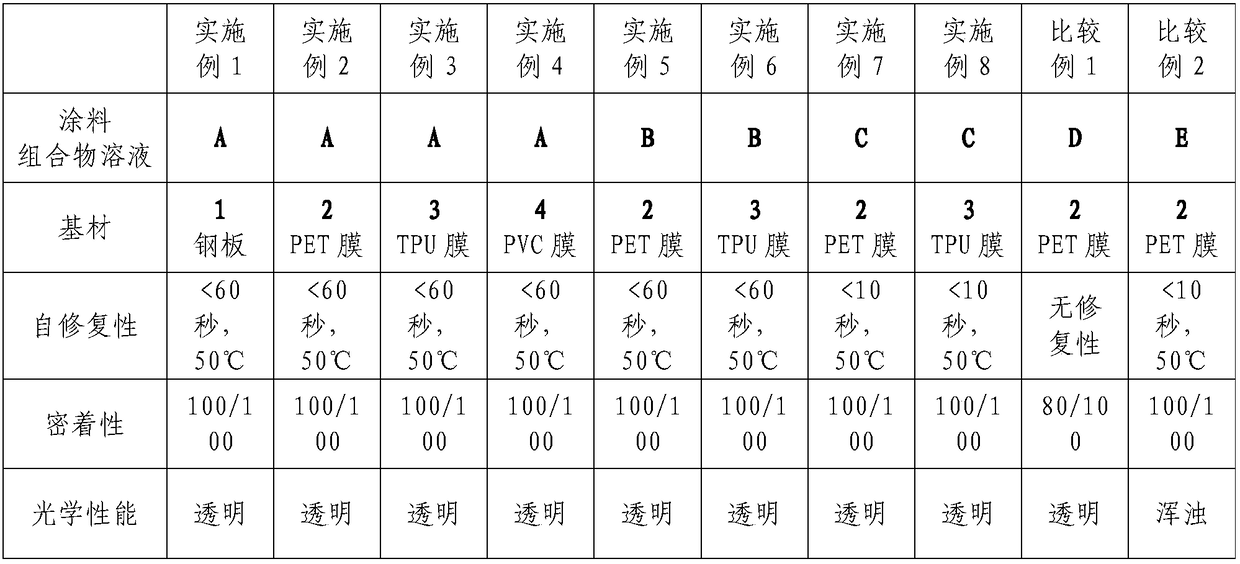Self-repairing coating composition, self-repairing coating layer, protective film containing coating layer and application of protective film
A self-healing and composition technology, applied in the field of self-healing coatings, protective films, and self-healing coating compositions, can solve the problems of insufficient UV resistance, high temperature and high humidity resistance, decreased self-healing performance of coatings, and disappearance. wait for the problem
- Summary
- Abstract
- Description
- Claims
- Application Information
AI Technical Summary
Problems solved by technology
Method used
Image
Examples
Synthetic example 1
[0056] Add 2-methyl-1,3-propanediol (369.5g, 4.1mol), diethyl carbonate (366.2g, 3.1mol), and the catalyst sodium ethoxide into a 1000ml three-necked volumetric flask equipped with a stirrer, thermometer and condenser. 20% ethanol solution (0.12g, 0.35mmol). Under a nitrogen atmosphere, keep the temperature at 100-120°C and continue to stir to distill out the by-product ethanol. When the amount of ethanol evaporated reaches 30-40% of the theoretical value, the temperature is increased to 170°C at a rate of 4-10°C / hour, and the temperature is maintained until the ethanol distillation is completed. Next, keep the temperature at 170°C, gradually reduce the pressure in the reaction device to 1.3kPa, continue the reaction for 2 hours for further reaction, and finally obtain a polycarbonate diol with a number average molecular weight of about 500, a molecular weight distribution of 1.8, and a Tm~-5 ℃, purity> 99% is recorded as A1.
Synthetic example 2
[0058] Add 1,5-pentanediol (244.75g, 2.35mol), 1,6-hexanediol (277.72g, 2.35mol), and diethyl carbonate to a 1000ml three-necked volumetric flask equipped with a blender, thermometer and condenser. Ester (366.2g, 3.7mol), catalyst sodium ethoxide 20% ethanol solution (0.14g, 0.41mmol). Under a nitrogen atmosphere, keep the temperature at 100-120°C and continue stirring to distill out the ethanol produced. When the distilled amount of ethanol reaches 30-40% of the theoretical value, the temperature is increased to 170°C at a rate of 4-10°C / hour, and the temperature is maintained until the ethanol distillation is completed. Next, keep 170°C, gradually reduce the pressure in the reaction device to 1.3kPa, continue the reaction for 2 hours for further reaction, obtain a polycarbonate diol with a number average molecular weight of about 500, a molecular weight distribution of 1.9, Tm ~ -10°C , Purity> 99% is recorded as A2.
Synthetic example 3
[0060] Using 315.4g of 2-methyl-1,3-propanediol (3.5mol), other conditions were the same as in Synthesis Example 1, and a polycarbonate diol with a number average molecular weight of about 1000 was obtained, with a molecular weight distribution of 2.0, Tm~-7℃ , Purity> 99% is recorded as A3.
PUM
| Property | Measurement | Unit |
|---|---|---|
| The molecular weight distribution | aaaaa | aaaaa |
Abstract
Description
Claims
Application Information
 Login to View More
Login to View More - R&D
- Intellectual Property
- Life Sciences
- Materials
- Tech Scout
- Unparalleled Data Quality
- Higher Quality Content
- 60% Fewer Hallucinations
Browse by: Latest US Patents, China's latest patents, Technical Efficacy Thesaurus, Application Domain, Technology Topic, Popular Technical Reports.
© 2025 PatSnap. All rights reserved.Legal|Privacy policy|Modern Slavery Act Transparency Statement|Sitemap|About US| Contact US: help@patsnap.com


